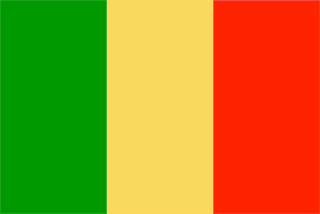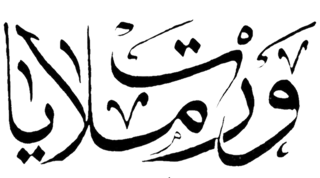
The national flag of Indonesia is a simple bicolor with two horizontal bands, red (top) and white (bottom) with an overall ratio of 2:3. It was introduced and hoisted in public during the proclamation of independence on 17 August 1945 at 56 Proklamasi Street in Jakarta, and again when the Dutch formally transferred sovereignty on 27 December 1949. The design of the flag has remained unchanged since.

The Federation of Malaya was a federation of what previously had been British Malaya, comprising eleven states that existed from 1 February 1948 until 16 September 1963. The Federation became independent on 31 August 1957, and in 1963, Malaysia was formed when Malaya united with Singapore, North Borneo, and Sarawak.

The Malaysian People's Party is a political party in Malaysia. Founded on 11 November 1955 as Partai Ra'ayat, it is one of the older political parties in Malaysia and traces its pedigree to the anti-colonial movements from the pre World War II period like the Kesatuan Melayu Muda.

The national flag of Malaysia, also known as the Stripes of Glory, is composed of a field of 14 alternating red and white stripes along the fly and a blue canton bearing a crescent and a 14-point star known as the Bintang Persekutuan. The 14 stripes, of equal width, represent the equal status in the federation of the 13 member states and the federal territories, while the 14 points of the star represent the unity among these entities. The crescent represents Islam, the country's state religion; the blue canton symbolises the unity of the Malaysian people; the yellow of the star and crescent is the royal colour of the Malay rulers. It is in the stars and stripes and the Muslim crescent flag families.
Ibrahim bin Yaacob was a Malayan politician. An opponent of the British colonial government, he was president and founder of the Kesatuan Melayu Muda (KMM). During World War II, he supported the Japanese during their occupation of Malaya and led the Malayan Volunteer Army. Arrested by the British colonial government, he was freed by the Japanese in February 1942, and went on to save hundreds of Malayan soldiers from being killed during the occupation; this saved him from being arrested by Force 136 after the war. He died in Jakarta on 8 March 1979.

Malay nationalism refers to the nationalism that focused overwhelmingly on the Malay anticolonial struggle, motivated by the nationalist ideal of creating a Bangsa Melayu. Its central objectives were the advancement and protection of Malayness: religion (Islam), language (Malay), and royalty. Such pre-occupation is a direct response to the European colonial presence and the influx of a foreign migrant population in Malaya since the mid-nineteenth century.

Greater Indonesia also Known as Indonesian Irredentism was a political concept that sought to bring the so-called Malay race together by uniting the territories of Dutch East Indies with the British Malaya and British Borneo. It was espoused by students and graduates of Sultan Idris Training College for Malay Teachers in the late 1920s, and individuals from Sumatra and Java, including Mohammad Natsir and Sukarno, on September 28, 1950. Indonesia Raya was adopted as the name of what later became the Indonesian national anthem in 1924. While the definition of Greater Indonesia is consistent, the definition of Greater Malay and related concept of Malay world and realm are varied from the synonym of Greater Indonesia to Peninsular-focused dominance.

Kesatuan Melayu Muda (KMM) was the first leftist and national political establishment in British Malaya. Founded by Ibrahim Yaacob and Ishak Haji Muhammad, KMM grew into a prominent pre-war nationalist movement, notable for its leftist political stance and willingness to use violence, a sharp break with their contemporaries in the Malay nationalist movement.
Tegakkan Bendera Kita is a Malaysian patriotic and national song. It was played by Sudirman Arshad on 1982.
Abdul Aziz bin Ishak (1915–1999) was a Malaysian freedom fighter, politician and journalist. Aziz was, in fact, the only member of the pre-war Kesatuan Melayu Muda (KMM) to have served in the 1955 and post-Merdeka Cabinets under Tunku Abdul Rahman. Between 1955 and 1963, he was the Minister for Agriculture and Co-operatives, where his efforts in rural development to improve the lives of padi farmers and fishermen were important although less known compared with similar efforts undertaken by the Rural Development Ministry.
Ahmad Boestamam, or Abdullah Thani bin Raja Kechil, was a Malaysian freedom fighter, politician and was the founding president of Parti Rakyat Malaysia and Parti Marhaen Malaysia.
Cik Dat bin Anjang Abdullah, commonly known as Abdullah CD, is a Malaysian former politician who served as chairman and General Secretary of the Communist Party of Malaya (CPM).

A tricolour featuring green, yellow and red, is a combination of colours that commonly found in varying designs of symbols adopted by some major organisations to symbolise the Malay people.
Najwan Halimi is a Malaysian politician who has served as Member of the Selangor State Executive Council (EXCO) in the Pakatan Harapan (PH) state administration under Menteri Besar Amirudin Shari since August 2023 and Member of the Selangor State Legislative Assembly (MLA) for Kota Anggerik since May 2018. He is a member of the People's Justice Party (PKR), a component party of the PH coalition. He is also the Deputy Division Chief of PKR of Shah Alam and served as the State Youth Chief of PKR of Selangor from January 2019 to June 2021. Najwan is one of the defence witness called by the Malaysian High Court in Anwar Ibrahim's second sodomy trial.
Mokhtaruddin Lasso (1915–1951) was a Sumatran-born Malayan independent guerrilla, a former anti-Japanese rebel during World War II who later became one of the founders of Parti Kebangsaan Melayu Malaya.

Mohamed bin Hamzah was a Malaysian vexillographer, soldier and architect. He was the designer of the Jalur Gemilang, that is the national flag of Malaysia.

Parti Kebangsaan Melayu Malaya (PKMM), also known as the Malay Nationalist Party, was founded on 17 October 1945 in Ipoh, Perak. The party was the first Malay political party formed after the Japanese occupation of Malaya.

Muslim People's Party of Malaya is a defunct political party formed in British Malaya on 17 March 1948. Hizbul Muslimin was also the first Islamist political party of Malaya set-up to fight for the Federation of Malaya independence from the British colonisation.

Warta Malaya, also known as Warta Melayu was a Singaporean and Malayan Malay-language daily newspaper. Written in Jawi script, the newspaper released its first issue in 1930. It later emerged as one of the highest circulating Malay newspapers of the 1930s. The newspaper was politically involved in the early stages of Malay nationalism, and became a paper for the Kesatuan Melayu Muda, an early Malayan left-wing political party. The final issue of the newspaper was published in 1942.























